European politics 1450–1600
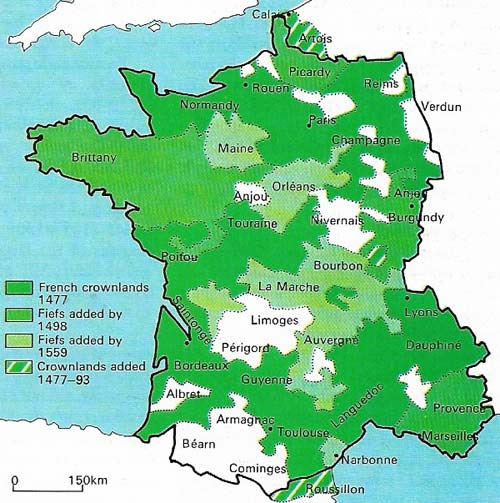
Figure 1.
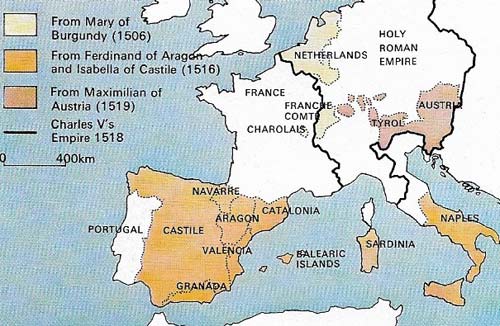
Figure 2. The empire of Charles V was the product of dynastic accident. He succeeded his father Philip as Duke of Burgundy in 1506, and his grandfather Ferdinand as King of Aragon and of Castile in 1516. The territories of the Holy Roman Empire came with his election to the title in 1519. There was no logic to the empire and problems of communication made imperial rule almost impossible. Charles Resolved these difficulties by handing The Netherlands (1555) and Spain (1556) to his son Philip II and the rest of his empire to his brother Ferdinand (1556).
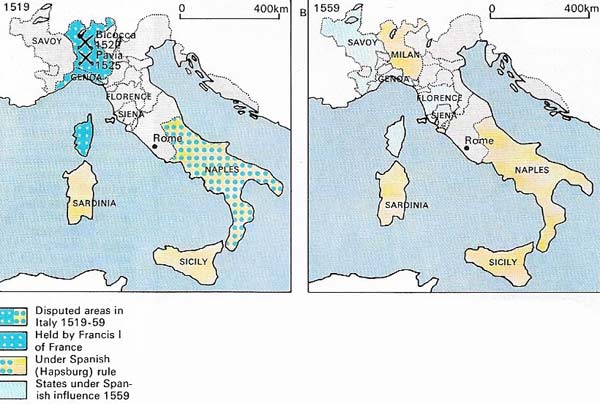
Figure 3. The warring Hapsburgs and Valois dominated early 16th-century politics. Charles V, of the Hapsburgs, inherited disputed claims over parts of Burgundy and Italy (A). Francis I, consolidating Valois rule in a France, feared encirclement by the Hapsburgs. The conflict entered on Italy, important for its wealth and a vital hub of communications in Spain and empire. The route through the Italian passes was the only alternative to the Channel route, which was not under Charles's control. Most of the disputed areas came under imperial control by the Peace of Cateau-Cambresis (1559) (B).
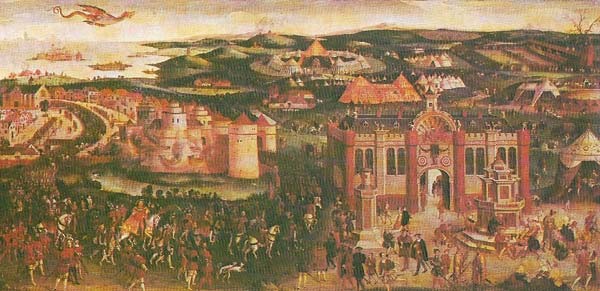
Figure 4. The "Field of the Cloth of Gold" is a painting that commemorates the historic meeting of King Henry VIII of England and King Francis I of France in June 1520 to conclude a long waited peace. The encounter was marked by great festivity and elaborate preparation. Henry had built a temporary palace, all tents were embossed with gold and velvet and the royal interviews were occasions for jousting and other contests of chivalry, ceremonial banquets and firework displays. As each king tried to outdo the other in pomp and splendor, the occasion turned into a trial of strength. No alliance resulted and open war had broken out by 1522.
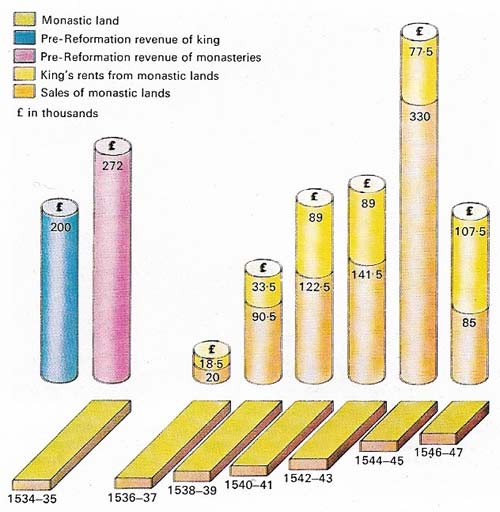
Figure 5. Henry VIII's Increased revenue from his dissolution of the monasteries, with the proportion received from the rent and sale of the lands, is shown here. Henry took this action four years after his break with Rome and claimed that he did it to put an end to corruption. But his real motive was to acquire an extra income for wars to further his dynastic ambitions in Europe.
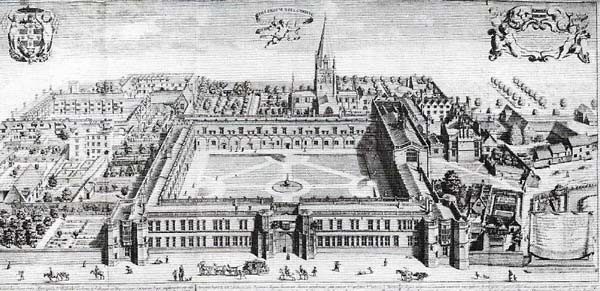
Figure 6. Christ Church (Cardinal's College), at Oxford was founded by Cardinal Wolsey (c. 1475–1530) in the 16th century. It's purpose was to train young scholars in philosophy, rhetoric, humanities and civil law. The educational foundations of the period owe much to the humanist belief in the relationship between education and the nobility of service to the realm.

Figure 7. Lisbon, central market for the spices of Asia, was the heart of a Portuguese empire that expanded east to the Indian Ocean and the Moluccan and west to Brazil. The population of this cosmopolitan city increased from about 50,000 in 1500 to more than 100,000 by the end of the sixteenth century. Similar developments in Amsterdam, Madrid, Antwerp, London and Paris were integral to the rise of the modern states. Capital cities, already centers of trade, also became the base of government and of court life.
Medieval Europe was the respublica christiana, the universal world of Christendom ruled by two swords – the spiritual wielded by the pope, the secular by the emperor. But the 16th century saw the disintegration of this ideal and the growth of monarchical states whose triumph was at the expense of the Church and the nobility. The process was at its clearest in France (Figure 1) where the crown gradually succeeded in converting lands held under the old feudal system into lands held by the crown, through a succession of accommodations between the crown, the papacy and the nobility.
Popes and kings
The disputed claim to the papal succession from 1378 to 1417 damaged the position of the pope as head of Christendom and the rival candidates became the puppets of secular rulers. Later popes retreated to play Italian politics while the princes of Europe exploited them to control the Church.
Monarchs of the 16th century attempted to increase their control over the nobility. The medieval king's real power rested ultimately on his wealth and the military strength that he could command. Towards the end of the Middle Ages a few noble families in many parts of Europe greatly extended their own power and fortunes. The Percy family, for example, had as much power in the north of England as kings. At times of weak kingship this situation produced civil war in France, Spain and England (the Wars of the Roses, 1455–1485). But the disorder of war threatened the privileged classes as a whole and they looked to a strong king to restore stability. The princes set about re-erecting the former effective monarchical rule based on financial resources, powerful adherents, the centralization of the administration and the neutralizing of the power of the independent nobles.
In England the Lancastrian Henry VII (1457–1509), who won his crown in battle, attempted to establish personal control of government. Henry enjoyed the forfeited lands of the vanquished and was financially stable. He administered the affairs of the realm from his own household and was able to discipline a nobility weakened by wars and to reduce the numbers of their military retainers. By marrying into the House of York he minimized the possibilities of dynastic rivalry. Henry rebuilt a strong personal monarchy in a realm that had seen nothing like it since Edward I (1239–1307). His son, Henry VIII (reigned 1509–1547) (Figure 5), continued to strengthen the crown: he incorporated Wales within the kingdom and brought the wealth and authority of the Church into his hands.
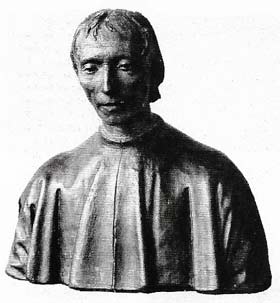 |
| The life of Nicolo Machiavelli (1469–1527) coincided with the rise of the nation state and the beginning of the art of statecraft. Machiavelli outlined a guide for princes in his book The Prince (1532), and his Discourses on the first ten books of Livy, the Roman historian. The Prince shocked Christian Europe and earned for its author a reputation for devious and treacherous statesmanship. He became a leading figure of the Renaissance. |
Francis I and Charles V
Francis I (1494–1547) came to the throne of France facing a difficult situation. France had been rent by war, nobles such as the Bourbon family were powerful and the kingdom was large and divided. Francis exploited the royal rights of direct taxation, centralized the treasury and attempted to impose uniform Roman law codes on all the provinces.
There seemed some hope for a degree of unity and centralization in Spain when the kingdoms of Aragon and Castile were both inherited by the Hapsburg Charles V (1500–1558) in 1516 (Figure 2). Charles suppressed the "comuneros" revolt and sent royal officials (corregidores) to enforce his will. But the nobility remained powerful and jealous of their privileges and the two kingdoms remained separate. Charles was distracted by his imperial duties (he was also Holy Roman Emperor) from consolidating Spain. In order to obtain Castilian money, he recognized the privileges of the nobles. Philip II (1527–1598) continued to rely on Castilian bullion for his campaigns and neglected Aragon, which voted little money to the crown. The kingdoms of Spain were never centralized and in the 1600s Aragon and Catalonia revolted against the crown.
When he became Emperor in 1519, Charles V tried to centralize his lands through imperial institutions and constant visits, but the task was impossible. The empire had no unity; large cities such as Nuremberg were proud of their independence, the princes were trying to assert themselves and powerful families such as the Wittelsbachs were anxious to stop the Hapsburgs from becoming too strong. The Reformation finally divided the empire. In the late sixteenth century the Hapsburgs gained control over their hereditary lands in order to provoke resistance in Bohemia.
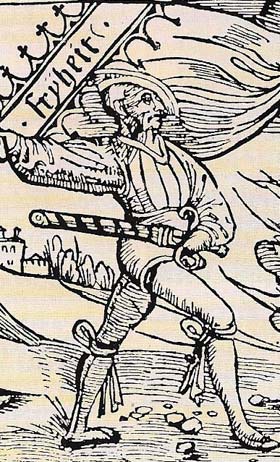 |
| Political propaganda in Reformation Germany is typified by this woodcut of a figure brandishing the banner of freedom. The development of printing, the growing respectability of vernacular languages and a period of religious and political conflict gave rise in the early sixteenth century to cartoon and broadsheets as a means of persuasion, pictorial representation had the widest appeal in an age of limited literacy. Monks were depicted as wolves and the enemies of Luther were caricatured. The method of contrasting woodcuts in juxtaposition was employed frequently. In one the Ascension of Christ was shown next to the descent of the pope into hell. |
Attempts by both Charles V and Francis I of France to increase control of their kingdoms led them into more than 40 years of war over disputed claims in Italy (Fig 3). Instead of becoming more unified, Italy was completely fragmented by the war.
The need for a strong monarchy
Although more powerful monarchies emerged in Western Europe during the sixteenth century, there were serious limitations on their control. Without a paid civil service kings still depended on the nobility. Men thought of Catalonia or Provence before they thought of Spain or France; allegiance to family, locality or lord could still overcome allegiance to the king. In the late sixteenth century religious divisions threatened the monarchy in England and encouraged a return to separatism in France. But the chaos of war once again alerted the ordinary nobles to the need for a strong king as the guardian of law and order.
